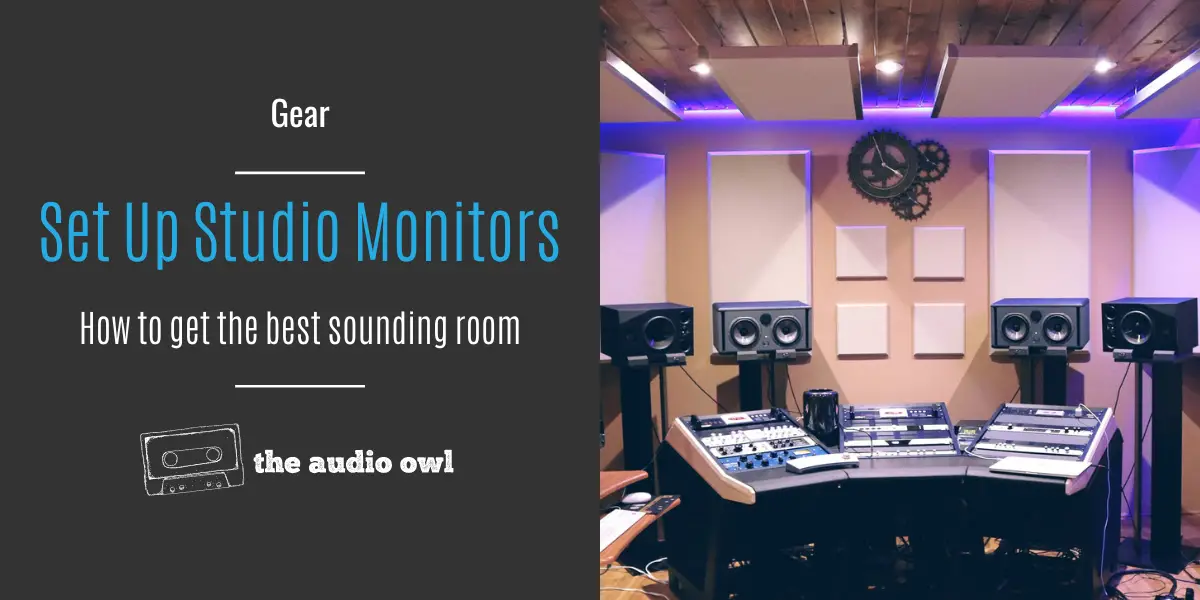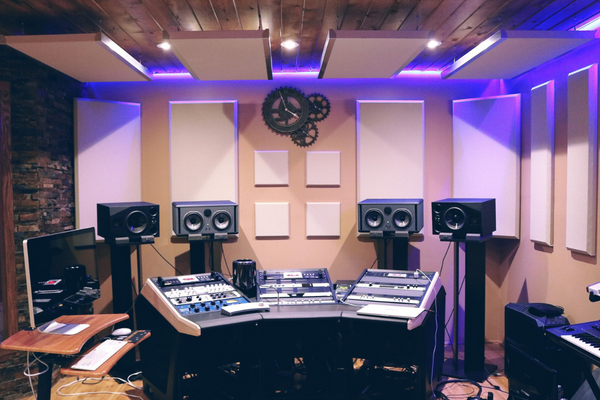Studio monitors are perhaps the most important tool you have in your music production arsenal. If your studio monitors are poor quality or not set up correctly, you won’t be able to hear an accurate representation of the sound of your music.
Unfortunately, many beginners and even advanced producers don’t set up their studio speakers correctly. Setting up your speakers wrong could result in undesirable effects such as lack of bass and comb filtering.
So how should you set up your studio to get the best possible sound? This article lists everything you need to know about how to set up studio monitors.
You Need an Audio Interface
One of the things beginners often don’t realize is that you can’t just plug studio monitors directly into your computer. Instead, you’ll need to plug them into an audio interface. An audio interface is essentially a box with audio inputs and outputs. They also might have other kinds of input and output such as MIDI.
Before buying any kind of studio monitor, you’ll need to have a good audio interface. Not only will an interface let you plug your monitors in, but it will also give you good sound quality.
An audio interface is essentially an external soundcard to your computer. If you’re using a commercial laptop, it will almost certainly be better than your existing card.
One thing to consider when setting up studio monitors is the number of outputs your interface has. Some interfaces have enough outputs to accommodate multiple sets of monitors, whereas others can only fit a single pair.
Consider the Room
When you listen to your monitor speakers, you’re not just hearing the speakers. You’re really hearing the sound of the room.
When you play your tracks, the sound will bounce off the walls and floors before hitting your ears. This means your speakers may sound very different in your room compared to someone else’s.
This can be a problem because as a music producer, you want to achieve clear mixes that hit hard on all kinds of playback devices. If your room setup is poor, you might get a great mix at home only to find it sounds terrible in your car.
Luckily there are a few rules of thumb that can help you get a better sound. First, your room should ideally be square or rectangular. If you have a room with extra alcoves or a weird shape, it’s going to cause issues with the sound.
Your listening position should be around 38% away from the front wall of your studio (the wall where your studio monitors are). Ideally, these speakers won’t be too far up against the wall. Putting your speakers too close to a wall can create an exaggerated bass response.
Studio Monitor Placement
You should place your speakers and yourself in such a way that you form an equilateral triangle with the speakers. Ideally, you’ll have the speakers far enough away that you can’t reach out and touch them from your sitting position. If you sit too close to your speakers, transient sounds will be greatly exaggerated, and you won’t have an accurate impression of your mix.
You should also ensure that the tweeters on your monitors aim directly at your ears. This will help to ensure the high-end sounds are clean and crisp. You may need to use monitor stands to get your speakers into the correct position.
Using stands also has another advantage. It helps to ensure the low-end rumble from your speakers isn’t amplified by a table. Again, this helps you to make more accurate mixing decisions.
Try experimenting with your monitor placement by playing the same sounds (such as the sounds from our free sample packs) in different positions around the room.
Room Treatment
The room treatment is one of the most important things about setting up studio monitors. This is when you use acoustic panels and bass traps to improve the room’s sound. Sound reflects from various points in the room before hitting your ears.
Room treatment allows you to tame these reflections by deadening the sound of the room. The treatment prevents the sound from bouncing endlessly around the room. This makes your speakers sound better and more accurate.
When you have a lot of sound reflection in your room, you might experience significant issues with the sound quality. For example, it could cause comb filtering, which makes it incredibly difficult to make any accurate mix decisions.
When budgeting for studio monitors, you should also include room treatment in the costs. It makes more sense to spend as much money on room treatment as you spend on the speakers themselves. In almost all cases, this will result in a better sound than spending your whole budget on speakers.
Consider a Subwoofer
If you make bass-based music such as house, techno, or hip hop, you’ll need to be able to hear the low end. Sub bass sounds from synthesizers and drum machines can be incredibly powerful, but you need to use them with caution.
Deep rumbles below 100hz may sound amazing in the club or in your car, but many studio monitors will struggle to recreate those frequencies accurately. A mix might feel like it lacks bass, so you EQ in some more to compensate. In reality, your monitors simply lack the lower range necessary to replicate the sound.
If you make the bass sound good on this kind of setup, it will be overwhelming in a club. If you’re mixing bass-heavy genres, you might also consider investing in a studio-quality subwoofer.
With that said, if you want a subwoofer, you’ll really need to have good quality room treatment. In untreated rooms, bass frequencies can cause a lot of problems. Putting a sub in an untreated room is often a waste of money.
Now You Know How to Set up Studio Monitors
As you can see, there’s a lot to consider when learning how to set up studio monitors. The key thing to remember is that the speakers themselves are only part of the budget. You’ll also need to pay for a good audio interface and for room treatment.
Do you want to learn more about audio production and take your skills to the next level? Check out our website for more informative articles.
Author: Mike P
Hi! My name is Mike! I’ve been an apartment producer/musician for 10+ years. I’ve played in punk bands, released EDM tunes on Beatport and iTunes, and have a semi-successful stock music portfolio. Read more…




